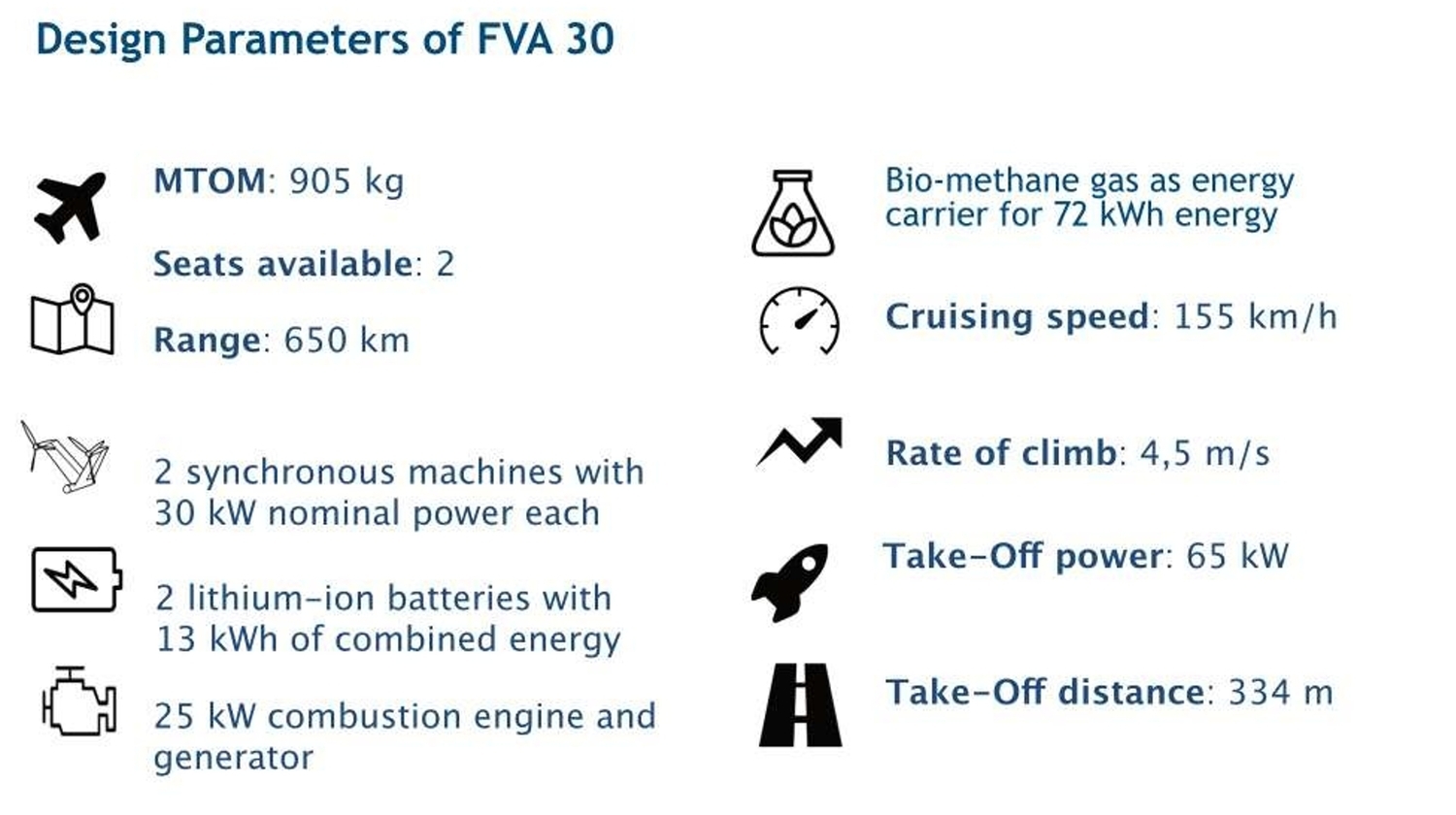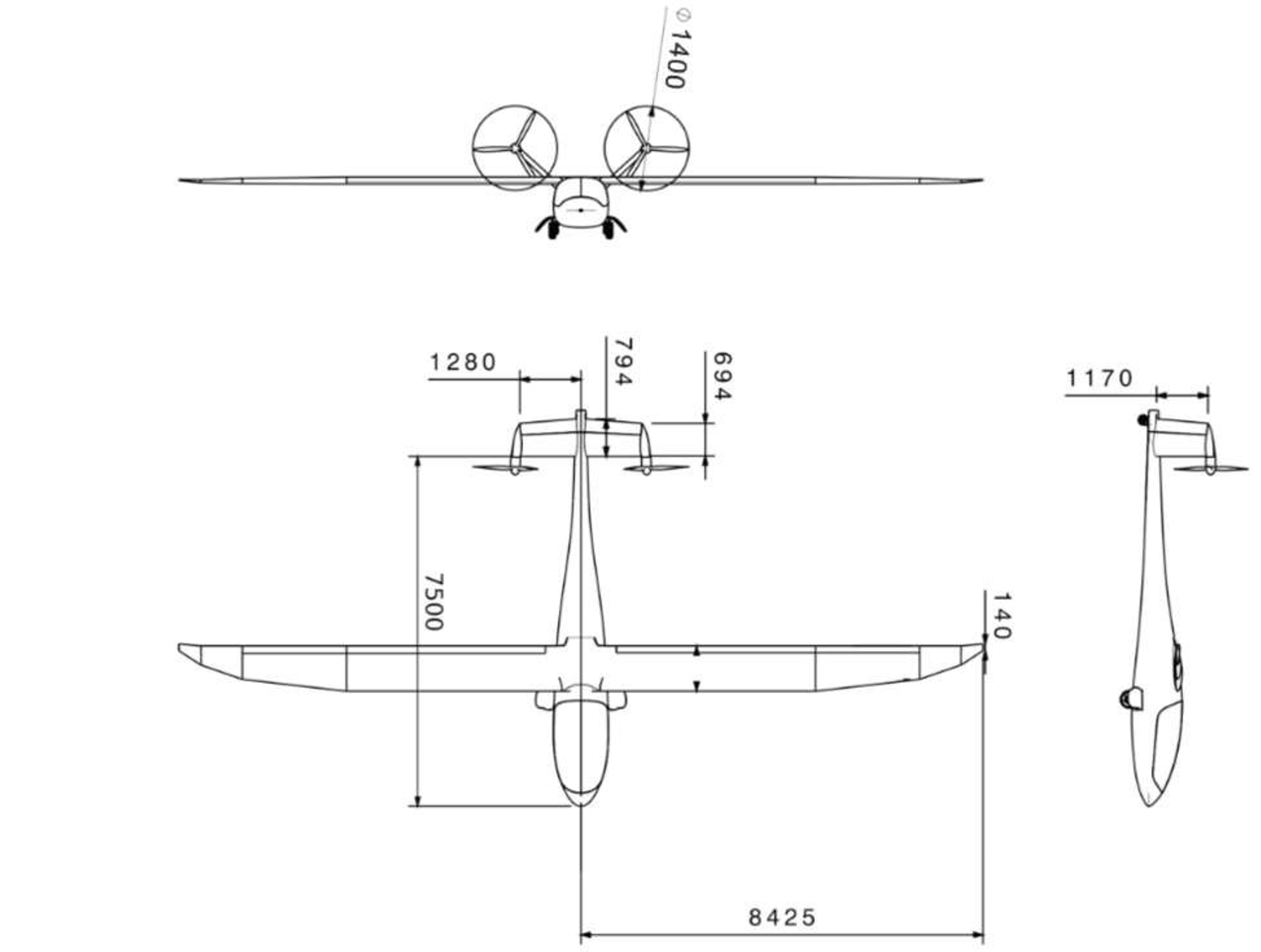Published: 22.02.2022 by Felix Diekmann, Eric Kortemeier
Abstract
The scientific aviation association (FVA) is developing the FVA 30, a hybrid electric motor glider, in order to research alternative propulsion systems. Due to strict safety requirements in aviation, the electric drivetrain must be reliable at all time and the responsible local aviation agency with jurisdiction requires evidence of compliance with the complex certification guidelines, which is a challenging and time-consuming task for aerospace manufacturers. This article focuses on the certification process of the FVA 30 power train, using a Speedgoat target computer.
FVA 30
The aircraft features two electric motors at the tail (Fig. 2). A high voltage lithium-ion battery pack directly behind the canopy provides enough energy for short flights powered exclusively by electricity. The fuselage contains two inverters to supply the engines with AC voltage. As a hybrid electric aircraft an additional generator and inverter connected to a propulsion engine charges the battery during the flight. This combination of a highly efficient electric powertrain with fuel as an additional energy source enables long flights with a range of up to 650km. (Fig. 1) [8]
Certification Guidelines
According to European Union regulation nr. 2018/1139 [5], which provides basic laws for aviation safety, the FVA 30 project does fall under the authority of the European Aviation Safety Agency as it is considered a research aircraft. The competent authority according to §2 of the LuftGerPV (the German federal ordinance on the testing of aircraft and aeronautical products) is the Luftfahrtbundesamt (LBA). [1] The LBA is part of the Federal Ministry of Transport and Digital Infrastructure and manages certification, approval and supervisory tasks in German aviation. [7] Since the FVA 30 will only be built once, the certification process will be loosely based on annex 1 of EU regulation nr. 748/2012 also referred to as ’Part 21’. This is stated in §3 LuftGerPV. [1] The core of the process consists of a certification program defined in close cooperation with the LBA. Firstly the LBA determines the applicable EASA certification specifications (CS): in this case, CS-22 (Sailplanes and Powered Sailplanes) was allocated. [6] Since current CSs do not cover electric aircraft, the preliminary Special Condition ’CS-22 Installation of electric propulsion units in powered sailplanes’ must also be met. [3]Another unusual attribute of the FVA 30 is its multi engine setup, which is uncommon in the class of (powered) sailplanes. Another special condition is therefore being established in cooperation with the LBA, which will include the paragraphs of CS-23 (Normal-Category Airplanes) applicable to multi engine aircraft. [4]
Figure 1: FVA 30 factsheet

Figure 2: FVA 30 design

Means of Compliance
Compliance must demonstrated with each single paragraph of the mentioned documents. This will be carried out based on an extensive list entitled Means of Compliance (MoC) and in accordance with the details set out in Table 1 below. With regard to the FVA 30 drivetrain, we will concentrate our efforts on design reviews, as well as laboratory and ground tests. The Speedgoat target machine can be used in conjunction with compliance methods number four ’Laboratory tests’ and number five ’Ground tests on related product’. The test programs will be performed and compliance-relevant data recorded. Before the verification phase commences, the means of compliance will be agreed with the LBA.
Laboratory Tests
In the first phase of the certification process, individual modules will be investigated for their use in aviation. For this purpose, an ironbird has been built, which is a setup of all the electronic components which will be installed in the future aircraft. The Speedgoat target machine can expose the system to faults, critical environmental conditions and flight cases years ahead of the flight testing phase, effectively shortening development time. These tests will be done according to existing specifications to guarantee an accurate recreation of the use cases and maximum safety. These specifications include RCTA DO-311, DO-160 and DO-178. Adhering to third party specifications for these tests not only saves time, but also ensures that the same level of safety can be reproduced for other aircraft. The results and logs of, for example, a fault insertion are then transferred into individual certification reports.
Table 1: Overview of verification methods (Source: EASA, [2])
| Type of Compliance | Means of Compliance | Associated Compliance Documents |
|---|---|---|
| Engineering evaluation | 0: Compliance statement, Reference to Type Design documents, selection of methods or factors, definitions | - Type Design documents - Recorded statements |
| 1: Design review | - Descriptions - Drawings | |
| 2: Calculation/ Analysis | - Substantiation reports | |
| 3: Safety assessment | - Safety analysis | |
| Tests | 4: Laboratory tests 5: Ground tests on related product 6: Flight tests 8: Simulation | - Test programs - Test reports - Test interpretations |
| Inspection | 7: Design inspection/ audit | - Inspection or audit reports |
| Equipment qualification | 9: Equipment qualification |
Ground and Flight Tests
Although all components are already tested before the construction phase, additional items must also be investigated in ground tests with the final assembled aircraft: for example, electromagnetic interferences can differ significantly from the effects observed on the ironbird test bench. Another important part of the ground test is to verify the calculated and simulated characteristics for accuracy. These tests are also conducted and documented by the Speedgoat real time target machine. Various measured values, for example cooling liquid temperatures are recorded over time and are appended to the certification documents. Each report will therefore demonstrate compliance with our MoC and will finally be provided to the LBA for examination. After a successful inspection, only the flight-testing requirements will be considered. Subsequently, the Speedgoat real time target machine will serve as the ECM and documentation tool to demonstrate further compliance.
Conclusion
As described in (2), electrifying the power train means that supplementary certification specifications must be met in addition to the usual certification specifications for powered sailplanes. Consequently, additional test bench runs are required. Using a real-time target computer from Speedgoat, the FVA can meet the additional specifications by implementing an ironbird for the FVA 30. The functionality of the electric system will be demonstrated in two stages: both in laboratory tests and on the assembled aircraft. Another part of the certification is the documentation for test reports. For this purpose, the FVA will use the Speedgoat target machine, which will also record measurements.
References
- Bundesministerium der Justiz und für Verbraucherschutz, Bundesamt für Justiz :Verordnung zur Prüfung von Luftfahrtgerät: LuftGerPV. https://eur-lex.europa.eu/legalcontent/EN/TXT/?uri=CELEX%3A32018R1139. Version: 15.02.2013
- EASA: Manual of Alternative Procedure to DOA - Template.https://www.easa.europa.eu/downloads/18653/en
- EASA: Special Condition - CS-22 - Installation of electric propulsion units in powered sailplanes: SC-22.2014-01. https://www.easa.europa.eu/downloads/16912/en . Version: 14.11.2014
- EASA: CS-23 Easy Access Rules for Normal-Category Aeroplanes - Amendment 5 - Issue 1. https://www.easa.europa.eu/downloads/106158/en . Version: 14.11.2019
- EASA: Regulation (EU) 2018/1139. </i>https://www.easa.europa.eu/document-library/regulations/regulation-eu-20181139 . Version: 22.08.2018
- EASA: CS-22 Sailplanes and Powered Sailplanes - Amendment 2. https://www.easa.europa.eu/downloads/1598/en .Version: 30.03.2009
- Luftfahrt-Bundesamt: Aufgaben und Ziele des Luftfahrt-Bundesamtes. https://www.lba.de/DE/LBA/Aufgabe/Aufgaben_node.html .Version: 20.01.2022
- Moxter, T. ; Enders, W. ; Kelm, B. ; Scholjegerdes, M. ; Koch, C. ; Garbade, M. ; Dahmann, P.:Investigation of Alternative Propulsion Concepts for Small Aircraft with the Hybrid Electric Motor Glider FVA 30